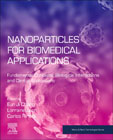
Nanoparticles for Biomedical Applications: Fundamental Concepts, Biological Interactions and Clinical Applications
Chung, Eun Ji
Leon, Lorraine
Rinaldi, Carlos
Nanoparticles for Biomedical Applications: Fundamental Concepts, Biological Interactions and Clinical Applications brings into one place information on the design and biomedical applications of different classes of nanoparticles. While aspects are dealt with in individual journal articles, there is not one source that covers this area comprehensively. This book fills this gap in the literature. Outlines an in-depth review of biomedical applications of a variety of nanoparticle classesDiscusses the major techniques for designing nanoparticles for use in biomedicineExplores safety and regulatory aspects for the use of nanoparticles in biomedicine INDICE: Part A. Biologically inspired 1. Liposomes 2. Carbohydrates 3. Virus Like Particles (Nicole Steinmetz, Case Western University) 4. Exosomes Part B. Metallic/inorganic 1. Gold (Qun Huo, University of Central Florida) 2. Iron oxide 3. Quantum Dots (Swadesh Santra, University of Central Florida) 4. Diamonds (Dean Ho, UCLA, and Edward Chow, National University of Singapore) 5. Ceramics Part C. Polymeric 1. PLLA/PLGA Part D. Self-assembled 1. Hydrophobically assembled a) Peptide amphiphiles (Eun Ji Chung, University of Southern California) b) Lipid/Nucleic Acid constructs (University of Illinois, Urbana Champagne) c) Block copolymer micelles 2. Electrostatic a) Coacervates, Polyelectrolyte Complexes (Lorraine Leon, University of Central Florida) b) Layer by Layer (Hammond or some ex. Hammond people?) Part E. Targeting 1. Active targeting a) antibodies (Molly Shoichet, University of Toronto) b) peptides (Kimberly Kelly, University of Virginia) c) aptamers d) carbohydrates 2. Passive targeting a) EPR effect (Warren Chan, University of Toronto, Stefan Wilhelm, University of Oklahoma) b) RES 3. Effects of Shape, Rigidity, size, and flow on Targeting (Lola Eniola, University of Michigan) Part F. Drug Delivery 1. Nucleic acids 2. Small molecules (Hongang Cui, Johns Hopkins University) 3. Proteins and therapeutic peptides (University of Central Florida) Part G. Diagnostic 1. MRI 2. Ultrasound 3. CT 4. Fluorescence/optical imaging 5. PET/SPECT/Raman 6. X-ray PartH. Immune system 1. Vaccines (Joel Collier, Duke University) 2. Immunotherapy (cancer) (John Wilson, Vanderbilit) 3. Immune tolerance (Lonnie Shea, University of Michigan) Part I. Clinically available nanoparticles (Maybe someone in industry?) Part J: Challenges 1. Barriers a) blood brain barrier b) first pass effect c) RES d) renal clearance 2. Routes of administration 3. FDA, scale up, cost (Maria Marlow, University of Nottigham) 4. Personalized medicine (Dean Ho, UCLA) Part K: Conclusions
- ISBN: 978-0-12-816662-8
- Editorial: Elsevier
- Encuadernacion: Rústica
- Páginas: 500
- Fecha Publicación: 01/09/2019
- Nº Volúmenes: 1
- Idioma: Inglés
